
Time Line of Decipherment
When the Spanish conquered the Maya empire in the 16th
century, they forced their new subjects to convert to
Christianity and speak and write in Spanish. But long before
the Maya used the Roman alphabet, they had created their own
rich and elegant script, featuring more than 800 hieroglyphs.
Sadly, the glyphs' meanings were lost in the decades following
the Conquest. Ever since, scholars have struggled to decode
these symbols, pronounce the words they form, and understand
the stories they tell. In this time line, follow the
centuries-long decipherment, which has only recently reached
the point where scholars can read more than 90 percent of the
glyphs.—Rima Chaddha
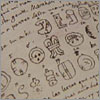

|
|
16th century
Surviving texts
The quest to decipher Maya hieroglyphs began with the
very Spanish invaders whose hegemonic rule did so much
to wipe out the ancient Maya script. Among them was the
conquistador Hernando Cortes, who led massacres in
Mexico but who also, some scholars believe, had the
famous Dresden Codex—one of just four Maya
illustrated books surviving today—shipped back to
Spain. Another was Diego de Landa, a friar bent on
replacing indigenous with Christian beliefs. In what
amounts to a crime against the cultural heritage of
humanity, Landa orchestrated the burning in 1562 of
hundreds if not thousands of Maya bark-paper books,
which he deemed heretical. Yet four years later, Landa
wrote a manuscript about the Maya world called "Relation
of the Things of Yucatan" (left). Together, this
manuscript and the Dresden Codex proved essential in the
later decoding of the Maya's calendar system and their
advanced understanding of astronomy and mathematics.
|
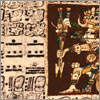

|
|
1832
Counting
Actual decipherment began with an eccentric European
genius named Constantine Rafinesque, who boasted of
having dabbled in more than a dozen professions, from
archeology to zoology. His insatiable thirst for
knowledge had led Rafinesque to a reproduction of just
five pages of the Dresden Codex, from which he was able
to crack the Maya's system of counting. In 1832,
Rafinesque declared in his newsletter, the
Atlantic Journal and Friend of Knowledge, that
the dots and bars seen in Maya glyphs (like these at
left, from the Dresden Codex) represented simple
numbers—a dot equaled one and a bar five. Later
findings proved him right and also revealed that the
Maya even had a symbol for zero, which appeared on
Mesoamerican carvings as early as 36 B.C. (Zero didn't
appear in Western Europe until the 12th century.)
|


|
|
1880
Math and astronomy
As with many early glyph-related discoveries,
serendipity may have played a role in the next major
step in decipherment. A librarian with a penchant for
mathematics named Ernst Förstemann just happened to
work at the Royal Library in Dresden, Germany, which
owned the Dresden Codex and after which it was named. He
also had access to Landa's "Relation." Using his unique
skill set, Förstemann decoded the astronomy tables
the Maya used to determine when, for example, to wage
war (at left are codex pages depicting the planetary
cycle of Venus). He also deciphered the Maya system for
measuring time, now called the Calendar Round. In this
system, dates cycle once every 52 years, much like dates
cycle annually in our Gregorian calendar. Later
Mayanists used Förstemann's discoveries to convert
Maya dates to Gregorian dates—for instance, the
Maya believed the world was created on August 13, 3114
B.C.
|
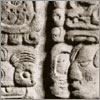

|
|
1881
Photo documentation
Britain's Alfred Maudslay was a respected diplomat, but
he would be best remembered for his work as an amateur
Mayanist. Fascinated by scholars' writings on the Maya
and by new advancements in photography, Maudslay set out
to create as complete a record as possible of the
civilization's architecture and art. Using a
large-format, glass-plate camera, he captured highly
detailed images of Maya sites, including clear close-ups
of the glyphs (left). He also prepared
papier-mâché casts of several carvings from
which accurate drawings were later made. Maudslay had
effectively given Maya studies its first systematic
corpus, or body, of inscriptions. This helped make
further decipherments possible, in part by bringing
glyphs to scholars who had limited access to the few
surviving Maya texts.
|
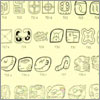

|
|
1930s
Giant steps—and missteps
By the 1930s, British researcher Eric Thompson was the
world's foremost expert in glyph studies. His
achievements included deciphering signs related to the
calendar and astronomy as well as identifying new words
from the Maya lexicon. Thompson also developed a
numerical cataloguing technique, the "T"-numbering
system, for each glyph (left). This enabled experts to
easily discuss symbols that had yet to be fully
understood or identified. Nevertheless, glyph studies
nearly came to a halt during this time, in large part
because Thompson had most scholars convinced that each
of the symbols in glyphs stood for entire words or
ideas. For instance, the glyph for "west" included a
well-known symbol for the sun and an as-yet unidentified
symbol depicting a nearly closed hand. Thompson
suggested that the hand meant "completion." And so
"west," where the sun sets, was symbolized by
"completion of the sun." It was a reasonable guess, but
one that, along with Thompson's more general take on the
glyphs, would be proven wrong.
|
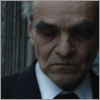

|
|
1952
The sounds of the glyphs
While glyph studies languished in the West, a Russian
linguist in Moscow was making his own groundbreaking
discoveries. In 1952, Yuri Knorosov (left) postulated
that the individual symbols in Maya glyphs stood for
phonetic sounds, much like English letters do. Knorosov
knew that Maya had too many glyphs to be a true alphabet
but too few for each glyph to symbolize an entire word.
(Maya's 800-plus glyphs compare to the several thousand
characters of Chinese, for example.) He determined that
written Maya, like Egyptian hieroglyphics, contained a
combination of these elements. Because "west," in spoken
Maya, is "chik'in," and "k'in" is the word for sun, the
hand represents the syllable "chi," as Knorosov
concluded. Fortunately, American scholars Michael and
Sophie Coe began publishing Knorosov's papers in the
U.S. in the late 1950s. Otherwise, his important (though
incomplete) findings might have been inaccessible to
Western scholars until the end of the Cold War.
|


|
|
1958
Uncovering Maya history
Tatiana Proskouriakoff was an architect by trade, but
faced with a scarce job market during the Great
Depression, the Russian-born American took work drawing
reconstructions of the ruins at Piedras Negras, a
Classic Maya site on the border between Mexico and
Guatemala (left). Later, while examining photographs of
the Piedras Negras stelae, or commemorative stone slabs,
Proskouriakoff noticed patterns in their dedication
dates. The Maya would set up a series of stelae in front
of a single temple, one every five years. The first
stela in each series always showed a seated figure.
Thompson had thought these were gods, but Proskouriakoff
convincingly proved that they were kings and that the
different markings on the stelae depicted their lives
from birth until death. When a ruler died, the Maya at
Piedras Negras would begin erecting stelae at another
temple, detailing the life story of another ruler. For
the first time, as Thompson and others came to agree,
the glyphs were found to tell the stories of the Maya.
|
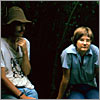

|
|
1973
Unveiling a dynasty
Concerned that Maya research was limited to a few
experts with special access to key resources, Merle
Greene Robertson, an American artist based at the
Classic Maya site of Palenque, built a center where
anyone could go to study the city's art and
inscriptions. In December 1973, 30 people came to the
center at Robertson's invitation, forming the first
major scholarly conference held at a Maya site.
Attendees included Robertson's assistant Linda Schele,
who had studied every Palenque inscription firsthand,
and Peter Mathews, an undergraduate who had spent the
previous year assigning Thompson's "T"-numbers to the
city's inscriptions. The duo (left, at the site) began
piecing together Palenque's history using a carving from
the site called the Tablet of the 96 Glyphs, which
researchers vaguely understood to depict a line of royal
accession. Within hours, and with a combination of luck
and an intimate knowledge of the glyphs, Schele and
Mathews accomplished something extraordinary: They
unveiled most of Palenque's dynastic history, including
the life stories of six rulers.
|


|
|
1981
In their own words
Before all the glyphs could be read aloud in the
original Maya, researchers needed to complete Yuri
Knorosov's phonetic decipherment. This began in 1981
when 15-year-old budding Mayanist David Stuart (left,
with Linda Schele) discovered that individual Maya words
could be written in multiple ways, using different
symbols for the same sounds, as in "faze" and "phase."
Eric Thompson's theory had been that the Maya wrote in
rebus, in which symbols are used for whole words. A
modern rebus of the phrase "I can see" might include
pictures of an eye, a tin can, and the sea. While some
glyphs can indeed be read this way, Stuart's
finding—that any symbol with the correct beginning
sound can be used to identify that sound in a word
glyph—is also true. As a result, a single glyph
could be drawn in dozens of ways. With this revelation,
scholars could now read many glyphs once considered
indecipherable.
|
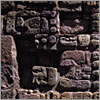

|
|
Present
Reviving ancient Maya
Scholars and the modern Maya can now read the majority
of glyphs, like these from Copan. They understand how
the ancient language was spoken compared to modern Maya
and have begun to grasp the lost civilization's
traditions by reading the stories carved on walls and
painted on pottery. From these images, they now know,
for example, that early Maya scribes held an exalted
status, each living like royalty and vying to develop
his own glyphic style. Though many traditional Maya
scribes today write in the Roman script, there has been
a push since the 1980s among Maya to relearn their
forebears' script and use it themselves. Maya are now
teaching the written language to one another in
workshops, while Maya schoolchildren are learning the
glyphs along with the history of their ancestors.

|
|


We recommend you visit the
interactive version. The text to the left is provided for printing purposes.
|











